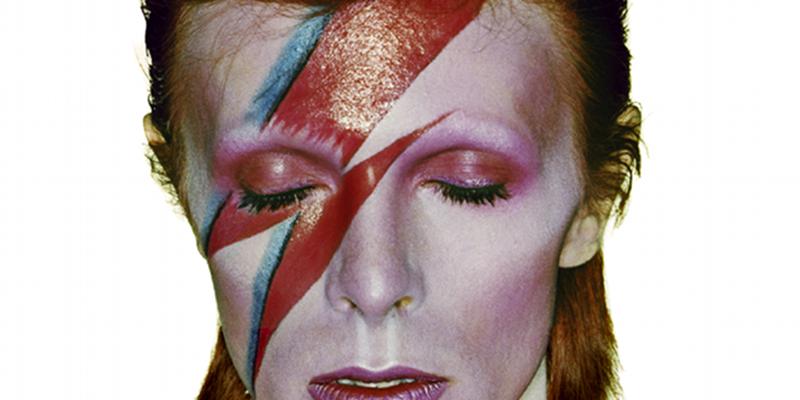Who, or what, is David Bowie? A globetrotting exhibition called David Bowie Is attempts to open up the question for interpretation, using a treasure-trove of items from his personal and professional life. David Bowie Is is also the title of a new documentary about the exhibition. While showcasing various items in the exhibit, the film also brings in intriguing guest speakers who were directly involved in Bowie’s ascent to cultural-icon status, like fashion designer Kansai Yamamoto, who refashioned kabuki-inspired designs “meant for his female clientele” to suit Bowie’s Ziggy-era needs. Yamamoto gets a little choked up when he recalls that, upon seeing Bowie descend to the stage wearing his design, he felt their “souls were united.” This type of sentiment recurs throughout David Bowie Is, until it really dawns on you how much Bowie means to so many people, maybe more than we realize.
Early on, there are vintage clips showing stuff that all us dyed-in-the-wool Bowie fans have seen before: a 17-year-old Thin White Duke fighting for the rights of boys with long hair, and his less well-known mime piece, “The Mask,” in which he struggles with a mask which cannot be removed, in much the same way that, years later, “Ziggy sucked up into his mind” and Bowie became engulfed by the character he’d created. Bowie eventually killed off Ziggy Stardust, announcing the character’s death at a concert in 1973, and one of the exhibit’s most haunting pieces is a sarcophagus containing a mannequin decked out in one of Ziggy’s more famous outfits, a green and white jumpsuit with matching platform boots. It feels a little like something you’d see at the British Museum in London, and that doesn’t seem accidental: This has to be one of the first times such an in-depth collection has been put together for, of all things, a “pop star,” in, of all places, a proper museum. But you simply can’t sum up David Bowie with a pair of trousers on display at the Rock & Roll Hall of Fame. He’s crossed into too many worlds and too many media for that. David Bowie Is makes a darn good stab at mapping such an extraordinarily varied body of work, and this documentary is a worthy compass.
The documentary bounces around in somewhat non-chronological fashion, but it seems to give a pretty good sense of the exhibit, prompting you to ponder the space between those personal items and Bowie himself. We see a photo of Little Richard purchased at Woolworth’s by a nine-year-old David Jones (his birth name) in 1956, and later we zoom in on Bowie’s classy yellow Italian-waiter get-up for the Serious Moonlight Tour — how different are they, really? Bowie seems to crush images and symbols together with a grace and complexity that no one has since been able to replicate.
We watch as Bowie’s influences become less visible on the surface. Early on, Marc Bolan and Iggy Pop make their unmistakable mark on Bowie, both musically and visually. Yet as we flash forward to 1977 and take a look at the starkly minimal music video for “Be My Wife,” a highlight of the comparatively restrained Low, we find a look better suited to a financial advisor on holiday in San Juan, and a sound more like Scott Walker. Bowie seems to utilize his influences like open-ended symbols that he imbues with a depth of his own, with restraint and reevaluation at each turn. This creates something altogether new. That’s his brilliance, right? This is a tempting conclusion, but like any good exhibit, this one challenges us to investigate further. What conjured this depth of emotion in such a way that it propelled a working-class boy from Bromley Technical School to become David Bowie? Nothing epitomizes this line of intrigue quite like a work commissioned especially for the exhibit: an illuminated block of rice meant to represent all of the children born in England in 1947. The year before, many soldiers had come home from the war, which created a huge spike in births the following year. Bowie and Bolan are just two small grains in the rice stack, leaving us to ponder, with odds like that, how did they ever pull it off?
An interview with renowned English playwright Hanif Kureishi, who later attended the same school Bowie did, summons up the mentality that Bowie himself was up against early on. Kureishi says, “We were brought up to be nobodies,” and goes on to reveal that one of his teachers even had a picture of Bowie tacked to the wall with a note that read, “If you act up, you’ll end up like that rat!” There’s a Roger Waters jam in there somewhere.
At one point, the focus shifts to a collection of sketches that Bowie drew in the early ’60s, of stage sets and costume designs, at a time when he was prone to playing in bands with names like the King Bees and the Konrads. Our host notes that young David had been putting it all together and “thinking big” right from the word go. The drawings, though quaint and childlike, reveal something more than just an aspiring musician: they reveal someone who’s driven, and thinking about the “big picture” beyond, as our curator and co-host Victoria Broackes puts it, “getting that first gig,” Even at this stage, Bowie displays great confidence in his craft, a confidence which would serve him well later, especially when dealing with his cigar-puffing manager Tony Defries.
Later in the film we’re shown a collection of storyboards created by Bowie. His intention was to create a theatrical production based on George Orwell’s Nineteen Eighty-Four but the Orwell estate stepped in and put the kibosh on the whole affair. The exhibit’s designers have taken the original storyboards and animated them to tantalize us further into pondering what might have been.… The architects of the David Bowie Is exhibition strive to relay the notion that these pieces are not only open to interpretation, but are catalysts to ignite the spectator’s imagination as to what those unbuilt worlds might look like. The film does a great job of transferring that excitement to the viewer.
Another example of this transferred wonderment appears later in the film, as the camera homes in on an illuminated piece of notebook paper on which the lyrics of “Rock ‘n’ Roll Suicide” are scrawled, blotches and all, with stuff crossed out here and there. You get goosebumps just looking at it. Our tour guide talks of the “alternate histories” that are revealed beneath the blotches, the stuff Bowie scratched out, and which hint at the possibility of alternate universes that could be. It makes you feel as though you’re sitting at some Soho café in 1972, sipping a coffee and watching Bowie work it all out. These are the moments when I think to myself, “Pay this month’s rent, or fly to Chicago to see this exhibit?”
One of the film’s most enjoyable moments, at least for me, is a charming video excerpt in which Bowie shows us how to use the Verbasizer. This computer program, developed by Bowie and friends, essentially takes William Burroughs’ famed cut-up method — earlier in the exhibit we see Bowie practicing it with pieces of paper — which crushes sentences down into different permutations. It offers up gems like “the top kills himself,” a line which prompts a cigarette-wielding early-’90s Bowie, perched at the computer, to visualize “a boss in the 1930s throwing himself out of the window in the Great Depression.” He praises the software’s ability to create “the images of the dream state without the boredom of trying to go to sleep, or the inconvenience of getting stoned out of your head!”
The doc includes some lively drop-in cameos by museum-goers, offering an egalitarian balance of perceptions, not to mention some chuckle-worthy moments. Quite a lot of folks raise the subject of trousers throughout the film, and sometimes they get a bit excited. One woman gazes upon Bowie’s 1976 Station to Station outfit, a real Gatsby number, which she considers his sexiest look. “I had a moment while looking at that one,” she says, longingly. Some things are better left unsaid.
As an avid Bowie fan, I was delighted to learn about the origins of “Space Oddity,” a song that’s seen almost as much rotation as Earth itself. The exhibition reveals that a photo taken from Apollo 8, the first distant image of Earth ever seen by humans, inspired Bowie to write the tune. We see the newspaper clipping that Bowie himself gazed upon in wonderment, something so small but, along with 2001: A Space Odyssey, so crucial to the creation of Major Tom. I’ll also admit to foaming at the mouth as the camera made its way through a room dedicated to Bowie’s Berlin period, complete with the original synthesizer used on Low.
In one of the film’s more tender moments, Pulp frontman Jarvis Cocker stands before a boisterous crowd at the Victoria and Albert Museum in London, recalling “Bowie Nights” back in Sheffield dance clubs, where “misshapes, mystics, and misfits were all welcome,” and getting about as choked-up as Jarvis Cocker can get. “Bowie,” he says, “provided this safe place where people could invent themselves, he was one of us.”
I once saw an interview with Bowie in which a talk-show host kept bombarding him with all the cliché questions about his sexuality, Mick Jagger, blah-blah-blah. At one point, though, Bowie said something that made the hair on the back of my neck stand up. He revealed that at the heart of what drives him is fear, like he’s running from something, hiding from something. It didn’t seem like the interviewer really registered the impact of what Bowie had said, but I’ve run that scene in my head so many times. It made him seem so human, so vulnerable, to reveal something which we all hold at our core. But we can escape it through imagination, the greatest product of the human mind. Bowie reminds us of that, and that’s why we love him: he’s one of us. That’s who David Bowie is.









